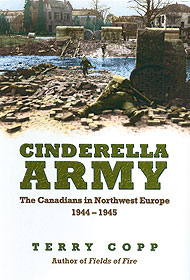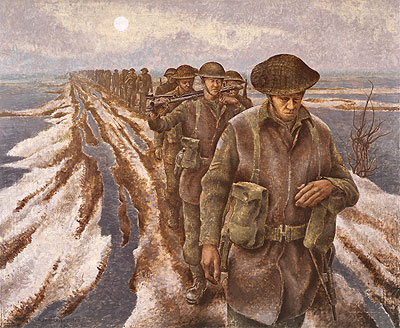 This information has been archived for reference or research purposes.
This information has been archived for reference or research purposes.
Archived Content
Information identified as archived on the Web is for reference, research or recordkeeping purposes. It has not been altered or updated after the date of archiving. Web pages that are archived on the Web are not subject to the Government of Canada Web Standards. As per the Communications Policy of the Government of Canada, you can request alternate formats on the "Contact Us" page.
Book Reviews
Cinderella Army: The Canadians In Northwest Europe, 1944-1945
by Terry Copp
Toronto: University of Toronto Press, 2006 407 pages, $45.00 (hardcover)
Reviewed by Bernd Horn
For more information on accessing this file, please visit our help page.
 Quite simply, there are no surprises with this book. It is a well-researched, authoritative account of the Canadians, specifically, the First Canadian Army, as it operated during the last nine months of the Second World War in Europe. But then, that is exactly what one would expect, coming from the seasoned hand of the well respected Canadian historian Terry Copp. Moreover, in the opening pages of the book, Copp quickly explains that this latest masterpiece is a sequel to his earlier Fields of Fire: The Canadians in Normandy. He also extends the argument he developed in that book, namely that the “achievements of the Allied and especially Canadian armies has been greatly under rated while the effectiveness of the German Army has been greatly exaggerated.”
Quite simply, there are no surprises with this book. It is a well-researched, authoritative account of the Canadians, specifically, the First Canadian Army, as it operated during the last nine months of the Second World War in Europe. But then, that is exactly what one would expect, coming from the seasoned hand of the well respected Canadian historian Terry Copp. Moreover, in the opening pages of the book, Copp quickly explains that this latest masterpiece is a sequel to his earlier Fields of Fire: The Canadians in Normandy. He also extends the argument he developed in that book, namely that the “achievements of the Allied and especially Canadian armies has been greatly under rated while the effectiveness of the German Army has been greatly exaggerated.”
Copp’s choice of title, Cinderella Army is also telling. His use of the well-known fairy tale title relates directly to challenges faced by the Canadian Army in late 1944, when it was severely depleted of resources, burdened with myriad difficult tasks, and shunted off to fight a number of seemingly low-priority battles on the periphery of the theatre. Despite these challenges, the Canadians emerged victorious, albeit bloodied.
The author begins his very crisp, fast-moving text with a quick summary of the Allied inability to destroy the withdrawing German Army west of the Seine River, a result of both national and personality-driven agendas. He then quickly zeros in on the First Canadian Army’s pursuit operations, as they commenced on 15 August 1944 along the coastal flank of the Normandy bridgehead.
Professor Copp ably captures a myriad of themes in his succinct encapsulation of the Allied failure to trap and destroy large remnants of the German army, as it made its escape from the Normandy cauldron. The complexity of the national commands and agendas, as well as the volatile personalities and situational factors that existed on the ground, are all clearly laid out – testimony to Copp’s grasp of the subject, and within the context of the military culture and coalition operations. He describes a kaleidoscope of activities of the Canadian units and formations, all of which are clearly woven together to provide a clear picture of the pursuit operations of the Canadians as they tried to destroy those withdrawing German forces. His examination and analysis with respect to the capture of Antwerp and the issue of securing the channel ports, particularly vis-à-vis the impact on Montgomery’s push for a major offensive against Arnhem with a view to exploding into the Ruhr Valley, is particularly intriguing.
Once again, Copp undertakes a reassessment of the Canadian performance. He contends that the First Canadian Army faltered badly during the pursuit to the Seine and the Scheldt Rivers. However, he insists that at the channel ports, commanders such as Simonds and Spry, along with their respective staffs, planned, and the soldiers of the 3rd Canadian Division then executed highly successful operations.
As mentioned earlier, but it bears reinforcement, the text is exceptionally well written. For instance, the narrative of the fight for the Brechens Pocket is simply illuminating. It captures the tactical fight in the mud and incessant cold rain with all the drama inherent in human struggle. However, it also clearly conveys the more operational and strategic complexities of the higher headquarters, such as the need for speed and resolute actions on the ground, reaction to the enemy’s counter-moves, and the impact of dwindling resources as they get stripped away for other “priority” efforts.
Similarly, his handling of various issues and subjects, such as the reinforcement debate, the operation for Walcheren Island, the savage battles for the Rhineland and the liberation of Holland, resound with the same clarity and detail previously mentioned. In addition, Copp, unlike so many others, takes a detailed look at the final month of the war, namely the campaign in Holland in April 1945. Although the final collapse of the Reich was arguably all but finished, the last weeks of the conflict still resulted in the deaths of 1191 Canadians.
In the end, Copp once again makes his point that, as Canadians, we should not be so quick to denigrate our performance. The Canadian component of the Allied armies in Northwest Europe never totalled much more than 185,000 troops out of an overall Allied army that numbered approximately four million. Despite their low numbers, Copp insists that the Canadians played a role out of all proportion to their numbers. After all, their contribution to secure the Channel ports and to open the approaches to Antwerp, together with the part they played in the battles for the Rhineland, place them among the most heavily committed and sorely tried divisions in the Allied armies.
Technically it is a very handsome book. It has extensive endnotes, a comprehensive index, and an excellent bibliography. The book also provides a wealth of excellent supplementary documentation in its incredibly revealing appendices, based upon selected wartime records and reports. These appendices cover such subjects as military estimates for specific operations, and lessons learned. In addition, there is a plethora of clear and detailed maps. Over 50 first-rate black- and-white photographs supplement the maps. Together, they provide situational awareness, as well as graphic images, that help bring the text to life.
In all, the book is a valuable addition to the body of Canadian literature dealing with the Second World War, a definite must-buy for history and military buffs, as well as those interested in the study of war. It is also strongly recommended for serving military members, as it provides excellent perspectives on the command and the conduct of war.
![]()
Colonel Bernd Horn, OMM, CD, PhD, an infantry officer, is currently Deputy Commander of Special Operations Forces Command.

Beaverbrook Collection of War Art CW 19710261-2079
Infantry Near Nijmegen, Holland, painting by Captain David (Alex) Alexander Colville.






